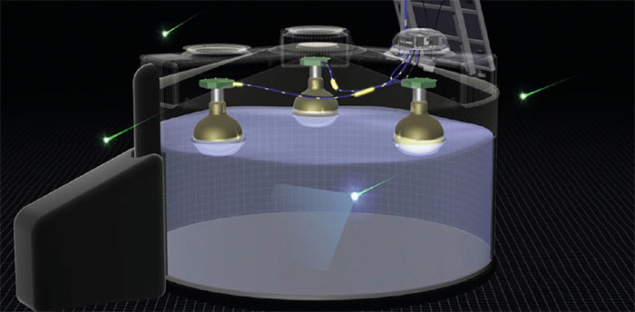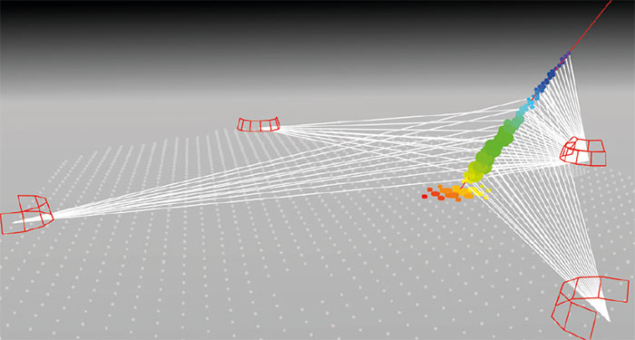The world’s largest cosmic-ray experiment, the Pierre Auger Observatory, is embarking on its next phase, named AugerPrime.

Image credit: Pierre Auger Collaboration.
Since the start of its operations in 2004, the Auger Observatory has illuminated many of the open questions in cosmic-ray science. For example, it confirmed with high precision the suppression of the primary cosmic-ray energy spectrum for energies exceeding 5 × 1019 eV, as predicted by Kenneth Greisen, Georgiy Zatsepin and Vadim Kuzmin (the “GZK effect”). The collaboration has searched for possible extragalactic point sources of the highest-energy cosmic-ray particles ever observed, as well as for large-scale anisotropy of arrival directions in the sky (CERN Courier December 2007 p5). It has also published unexpected results about the specific particle types that reach the Earth from remote galaxies, referred to as the “mass composition” of the primary particles. The observatory has set the world’s most stringent upper limits on the flux of neutrinos and photons with EeV energies (1 EeV = 1018 eV). Furthermore, it contributes to our understanding of hadronic showers and interactions at centre-of-mass energies well above those accessible at the LHC, such as in its measurement of the proton–proton inelastic cross-section at √s = 57 TeV (CERN Courier September 2012 p6).
The current Auger Observatory

Image credit: Pierre Auger Collaboration.
The Auger Observatory learns about high-energy cosmic rays from the extensive air showers they create in the atmosphere (CERN Courier July/August 2006 p12). These showers consist of billions of subatomic particles that rain down on the Earth’s surface, spread over a footprint of tens of square kilometres. Each air shower carries information about the primary cosmic-ray particle’s arrival direction, energy and particle type. An array of 1600 water-Cherenkov surface detectors, placed on a 1500 m grid covering 3000 km2, samples some of these particles, while fluorescence detectors around the observatory’s perimeter observe the faint ultraviolet light the shower creates by exciting the air molecules it passes through. The surface detectors operate 24 hours a day, and are joined by fluorescence-detector measurements on clear moonless nights. The duty cycle for the fluorescence detectors is about 10% that of the surface detectors. An additional 60 surface detectors in a region with a reduced 750 m spacing, known as the infill array, focus on detecting lower-energy air showers whose footprint is smaller than that of showers at the highest energies. Each surface-detector station (see image above) is self-powered by a solar panel, which charges batteries in a box attached to the tank (at left in the image), enabling the detectors to operate day and night. An array of 153 radio antennas, named AERA and spread over a 17 km2 area, complements the surface detectors and fluorescence detectors. The antennas are sensitive to coherent radiation emitted in the frequency range 30–80 MHz by air-shower electrons and positrons deflected in the Earth’s magnetic field.
The motivation for AugerPrime and its detector upgrades

Image credit: Pierre Auger Collaboration.
The primary motivation for the AugerPrime detector upgrades is to understand how the suppressed energy spectrum and the mass composition of the primary cosmic-ray particles at the highest energies are related. Different primary particles, such as γ-rays, neutrinos, protons or heavier nuclei, create air showers with different average characteristics. To date, the observatory has deduced the average primary-particle mass at a given energy from measurements provided by the fluorescence detectors. These detectors are sensitive to the number of air-shower particles versus depth in the atmosphere through the varying intensity of the ultraviolet light emitted along the path of the shower. The atmospheric depth of the shower’s maximum number of particles, a quantity known as Xmax, is deeper in the atmosphere for proton-induced air showers relative to showers induced by heavier nuclei, such as iron, at a given primary energy. Owing to the 10% duty cycle of the fluorescence detectors, the mass-composition measurements using the Xmax technique do not currently extend into the energy region E > 5 × 1019 eV where the flux suppression is observed. AugerPrime will capitalise on another feature of air showers induced by different primary-mass particles, namely, the different abundances of muons, photons and electrons at the Earth’s surface. The main goal of AugerPrime is to measure the relative numbers of these shower particles to obtain a more precise handle on the primary cosmic-ray composition with increased statistics at the highest energies. This knowledge should reveal whether the flux suppression at the highest energies is a result of a GZK-like propagation effect or of astrophysical sources reaching a limit in their ability to accelerate the highest-energy primary particles.

Image credit: Pierre Auger Collaboration.
The key to differentiating the ground-level air-shower particles lies in improving the detection capabilities of the surface array. AugerPrime will cover each of the 1660 water-Cherenkov surface detectors with planes of plastic-scintillator detectors measuring 4 m2. Surface-detector stations with scintillators above the Cherenkov detectors will allow the Auger team to determine the electron/photon versus muon abundances of air showers more precisely compared with using the Cherenkov detectors alone. The scintillator planes will be housed in light-tight, weatherproof enclosures, attached to the existing water tanks with a sturdy support frame, as shown above. The scintillator light will be read out with wavelength-shifting fibres inserted into straight extruded holes in the scintillator planes, which are bundled and attached to photomultiplier tubes. Also above, an image shows how the green wavelength-shifting fibres emerge from the scintillator planes and are grouped into bundles. Because the surface detectors operate 24 hours a day, the AugerPrime upgrade will yield mass-composition information for the full data set collected in the future.

Image credit: Pierre Auger Collaboration.
The AugerPrime project also includes other detector improvements. The dynamic range of the Cherenkov detectors will be extended with the addition of a fourth photomultiplier tube. Its gain will be adjusted so that particle densities can be accurately measured close to the core of the highest-energy air showers. New electronics with faster sampling of the photomultiplier-tube signals will better identify the narrow peaks created by muons. New GPS receivers at each surface-detector station will provide better timing accuracy and calibration. A subproject of AugerPrime called AMIGA will consist of scintillator planes buried 1.3 m under the 60 surface detectors of the infill array. The AMIGA detectors are directly sensitive to the muon content of air showers, because the electromagnetic components are largely absorbed by the overburden.
The AugerPrime Symposium
In November 2015, the Auger scientists combined their biannual collaboration meeting in Malargüe, Argentina, with a meeting of its International Finance Board and dignitaries from many of its collaborating countries, to begin the new phase of the experiment in an AugerPrime Symposium. The Finance Board endorsed the development and construction of the AugerPrime detector upgrades, and a renewed international agreement was signed in a formal ceremony for continued operation of the experiment for an additional 10 years. The observatory’s spokesperson, Karl-Heinz Kampert from the University of Wuppertal, said: “The symposium marks a turning point for the observatory and we look forward to the exciting science that AugerPrime will enable us to pursue.”
While continuing to collect extensive air-shower data with its current detector configuration and publishing new results, the Auger Collaboration is focused on finalising the design for the upgraded AugerPrime detectors and making the transition to the construction phase at the many collaborating institutions worldwide. Subsequent installation of the new detector components on the Pampa Amarilla is no small task, with the 1660 surface detectors spread across such a large area. Each station must be accessed with all-terrain vehicles moving carefully on rough desert roads. But the collaboration is up to the challenge, and AugerPrime is foreseen to be completed in 2018 with essentially no interruption to current data-taking operations.
• For more information, see auger.org/augerprime.








